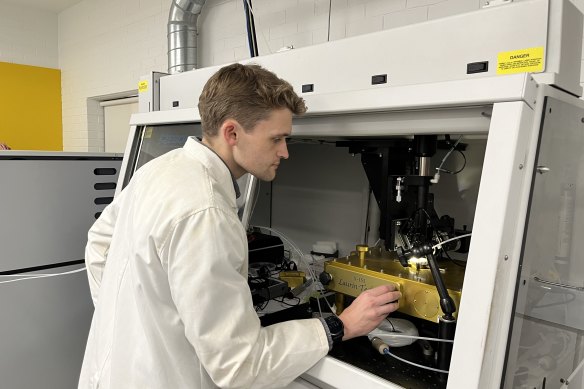New research led by Western Australia’s Curtin University has revealed Stonehenge’s monumental six-tonne Altar Stone, long believed to originate from Wales, actually hails from Scotland.
The findings point to unexpectedly advanced transport methods and social organisation at the time of the stone’s arrival at its current location in southern England, about 5000 years ago.

Curtin PhD candidate Anthony Clarke and Professor Chris Kirkland at Stonehenge.Credit: Curtin University
Curtin researchers studied mineral grains within fragments of the sandstone block, which measures five by one metres and is 50 centimetres thick, at the centre of Stonehenge’s stone circle in Wiltshire.
Lead author, PhD student Anthony Clarke from Curtin’s School of Earth and Planetary Sciences, said analysis matched these with rocks from northeast Scotland, and clearly differentiated them from Welsh bedrock.
“Our analysis found specific mineral grains in the Altar Stone are mostly between 1000 to 2000 million years old, while other minerals are around 450 million years old,” Clarke said.
“This provides a distinct chemical fingerprint suggesting the stone came from rocks in the Orcadian Basin, Scotland, at least 750 kilometres away from Stonehenge.
“The findings raise fascinating questions, considering the technological constraints of the Neolithic era, as to how such a massive stone was transported over vast distances around 2600 BC.
“This discovery also holds personal significance for me. I grew up in the Mynydd Preseli, Wales, where some of Stonehenge’s stones came from. I first visited Stonehenge when I was one year old and now at 25, I returned from Australia to help make this scientific discovery.”
Study co-author Professor Chris Kirkland, who like Clarke is with the Timescales of Mineral Systems Group at Curtin, said the findings had significant implications for understanding ancient communities.
“Our discovery of the Altar Stone’s origins highlights a significant level of societal coordination during the Neolithic period and helps paint a fascinating picture of prehistoric Britain,” Professor Kirkland said.
“Transporting such massive cargo overland from Scotland to southern England would have been extremely challenging, indicating a likely marine shipping route along the coast of Britain.

Clarke studying samples in the lab.Credit: Curtin University
“This implies long-distance trade networks and a higher level of societal organisation than is widely understood to have existed during the Neolithic period in Britain.”
The Australian Research Council funded research was performed in collaboration with Aberystwyth University, The University of Adelaide and University College London.
The study, ‘A Scottish Provenance for the Altar Stone of Stonehenge’, will be published in the journal Nature.
Stonehenge’s stones form different circles brought to the site at different times. The placement allows for the sun to rise through a stone “window” during summer solstice. The ancient purpose of the altar stone — which lies flat at the heart of Stonehenge, now beneath other rocks — remains a mystery.
“Stonehenge isn’t a settlement site, but a place of ceremony or ritual,” said Heather Sebire, senior curator at English Heritage, who was not involved in the study. She said that past archaeological excavations had not uncovered evidence of feasting or daily living at the site.
With AP